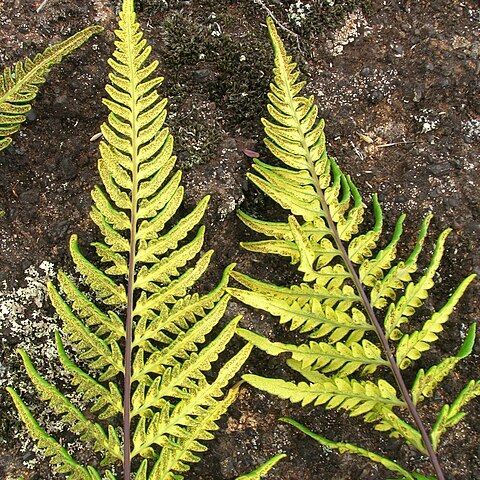Plants terrestrial. Rhizomes erect or ascending, short, dictyostelic; scales reddish brown, thin, lanceolate, margins entire. Fronds monomorphic, clustered; stipe purplish black, lustrous, rounded proximally, upward with single longitudinal groove adaxially, base scaly, glabrous distally; lamina 2-or 3-pinnate, ovate to oblong in outline, apex acuminate. Pinnae many, oblique, lanceolate, somewhat stalked, 2-or 3-pinnate, herbaceous to somewhat leathery, abaxially white or yellow farinose, adaxially glabrous, base subequilateral, apex acuminate. Pinnules many, anatropous, base inequilateral, usually adnate to costae, margins serrate. Veins of ultimate segments free, obscure, pinnately branched or not. Indusia absent. Sori along veins but not to vein tips, without paraphyses. Spores dark colored, globose-tetrahedral, perispore reticulate with irregular ridges. x = 29(30).
Rhizome erect, or (not in Australia) ascending or creeping, scaly towards apex; scales linear, attenuate, brown, with entire margins. Stipes tufted or (not in Australia) spaced along the rhizome, dark brown to almost black at the base, glabrous except for a few scales near the base. Lamina 2–4-pinnate, herbaceous to thinly coriaceous, with a white or golden yellow or (not in Australia) pink or orange waxy coating on the lower surface formed by short, glandular hairs, glabrous above; veins free. Sori exindusiate, borne along the length of the veins, at maturity often confluent over most of the laminal surface; paraphyses lacking. Spores tetrahedral, globose with broad ridges.
Sori along whole length of veins on lower surface

